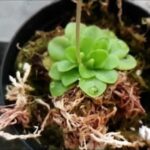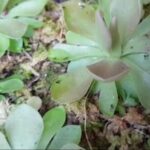As an Amazon Associate, this site earns commissions from qualifying purchases. For more details, click here.
Pinguicula conzattii was discovered in Oaxaca, Mexico and is renowned for its violet and white flowers. These butterworts grow in altitudes up to 8850 feet (2700 m). Not a lot is known about p. conzattii, but we do know enough to grow it successfully. Follow these steps and you will see how straightforward caring for the plant is.
Like other Mexican butterworts, pinguicula conzattii grows best in 55-85 F and under partial light. Use perlite and vermiculite for the soil and always keep it damp. The humidity should be 40-70% and the plant must have access to insects, bloodworms or fish beta pellets.
Pinguicula Conzattii Care Sheet
| Soil | 1:1 vermiculite and perlite. moist soil |
| Water | Natural, distilled, spring water |
| Light | Partial light, indoors or outdoors |
| Food | Flies, spiders, small bugs, fish food, mealworms |
| Temperature | 55-85 F (12.7-29.4 C) |
| Humidity | 40-70% |
| Dormancy | None, but carnivorous leaves replaced by succulent rosette in winter |
| Propagation | Leaf pullings |
Soil
Pinguicula conzattii grows in poor soil only. It relies on insects and other prey for nutrients, but soil is still important of course. Knowing what potting media to use is crucial to care for this plant.
The best soil mix for pinguicula conzattii is 1:1 vermiculite and perlite. You may also add silica sand. In general, P. conzattii does not seem choosy about the soil. As long as the mix is low in nutrients it should be fine. Others prefer to use peat moss with perlite or combine vermiculite, peat and perlite. Our preferred choice is Halatool Natural Sphagnum Moss Potting Mix.
Keep the soil damp during the growth phase. You can let the soil dry in winter after the plant forms its rosette.
You can buy p. conzattii with or without a soil mix. If you are new to this, buy a carnivorous soil mix so you can plant right away. If you want to make a custom media, just buy the bare root and buy the soil separately. Never use ordinary potting soil for pinguicula conzattii or any carnivorous plant.
Pot Container
A mature p. conzattii is 4 inches in diameter, so a 4-5 inch pot is ideal. Any material will be fine, even cheap plastic as long as it is waterproof.
Some like to grow their butterworts on rocks instead of pots. You can do that with p. conzattii as well. Choose rocks with indents and fill it with soil. Plant your pinguicula, water and place in a sunny, humid location.
Once in the pot – or rock, whichever you chose- just focus on care and maintenance. As long as the plant is healthy you do not have to repot. You can repot butterworts but it is not required unlike with other plants.
You only need to move it to another container if p. conzattii if it is infested, the soil is contaminated or there is some disease affecting the plant. In those instances you have to prune the unhealthy parts before repotting.
Water
Water pinguicula conzattii to keep the soil moistened at all times. After the plant forms its winter rosette, reduce watering and let the soil dry. Water only occasionally.
If you have pinguicula sethos or any other carnivorous plant, you probably already know that tap water should be avoided. Distilled water is the preferred choice as well as spring and rainwater. If you must use tap water, make certain its chlorine level is low. T
A lot of beginners end up overwatering their pings out of fear the soil could dry out. To keep it simple, water until the soil is damp. When the soil is moist to the touch, stop. Water again when it starts to dry out. o be safe and sure, we suggest Snugell Distilled Water as it is proven healthy for plants.
Experienced growers can tell if soil is damp, dry or too wet. The simplest solution is to use a moisture device. If you prefer the manual approach, touch the soil with your finger. If dirt sticks but does not feel too wet, then it is moist.
Light
For pinguicula conzattii, partial light is the best. Place the pot on a sunny window or partially shaded in your garden. Indirect lighting is ideal whether you use natural or grow lights.
Partial or indirect light means the sun is not directly on the pinguicula. While butterworts benefit from light, too much of it leads to dryness. The mucus on its leaves will dissipate and make it impossible for the pant to catch anything.
If you are growing your p. conzattii indoors, just look for a south facing windowsill. Leave the pot and position it to get as much of the morning light as possible. Simply move the pot if the sun gets too hot later in the day.
If your pinguicula is going to be in your garden, take the same approach. Position the plant so that the sun shines on it indirectly. As long as the temperature is below 90 degrees and there is enough humidity, the plant will thrive.
Temperature
Butterworts are actually easy to grow when in the right temperature range. Fortunately, most Mexican butterworts grow in roughly the same type of climate.
Pinguicula conzattii grows in 55-85 F (12.7-29.4 C) and cannot survive in freezing winter. For the best results, keep the plant in the same temperature range all the time.
To keep things simple, keep p. conzattii in warm, humid location. If you live in mild, tropical conditions it is safe to leave the plant outdoors. If it gets freezing cold, grow the plant indoors. Or at the very least, take the plant inside before winter frost sets in.
Some p. conzattii are known to thrive in 90 degree conditions. While 85 degrees is the ideal maximum level, you can keep the plant higher temperature if humidity is high enough. As long as you can keep the soil moist – and the leaves do not dry up – your pinguicula will survive.
Humidity
The humidity requirements of pinguicula conzattii is similar to other tropical butterworts. Just like with other carnivorous plants, humidity plays a key role in keeping the plant healthy.
Pinguicula conzattii should be grown in at least 40% humidity. The ideal rate is 70%, but higher levels will not cause any harm.
Most tropical butterworts prefer a warm, humid environment. The full sun contrasts nicely with its wet, humid surrounding and stimulates growth. This is why humidity is so important for p. conzattii.
A humidifier will come in handy but if you live in a tropical climate it might not be necessary. But keep in mind that humidity is just one factor. As long as the plant gets water, light, the right soil and temperature, less than ideal humidity will not be an issue.
Nutrition and Feeding
One of the biggest concerns of new ping growers is feeding, but it should not be. Feeding p. conzattii is no different from pinguicula balcanica or any other ping. If you grow these butterworts in the right environment, you do not have to worry about feeding and nutrition.
Butterworts can survive without eating because they make their own food through photosynthesis. But nutrients from insects provide additional benefits so it helps a lot.
If your ping is able to trap bugs, then you do not have to provide any more nourishment. The only time you have to hand feed p. conzattii is if it cannot eat. For example, you are growing the plant indoors and there are no insects around it. In that case, give food to your pinguicula every two weeks.
Dormancy
Pinguicula conzattii does not require dormancy. Instead of dying, this pinguicula sheds its carnivorous leaves and forms a non-carnivorous winter rosette.
These butterworts have two forms, carnivorous and non-carnivorous. When the plant is in its carnivorous form, care for it in the manner suggested in this guide. Once the pinguicula turns into a winter rosette, let the plant dry with occasional watering.
Leave your p. conzattii in this state during winter, watering only on occasion. As spring arrives, the plant will slowly grow new leaves.
You can start watering the plant again, but do it slowly. The more leaves that grow, the more you can water it. You can also increase its exposure to light. It might take some time before mucus develops on its leaves so be patient. When it does, your pinguicula conzattii will start catching and eating prey again.

My fascination with carnivorous plants began many, many years ago with Venus Fly Traps. Now I am more than happy to impart what I know with other enthusiasts and those who are curious about meat eating plants.



